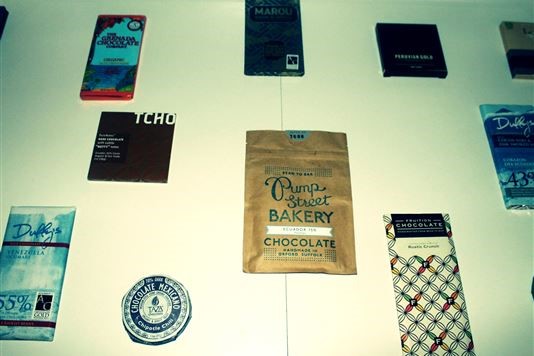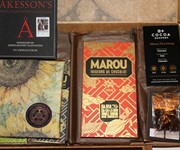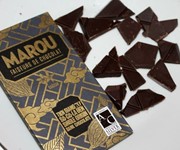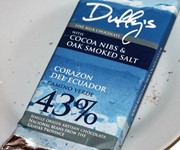How to eat artisan chocolate

There’s a chocolate revolution coming. We sent chocaholic Elizabeth Ryan to a tasting event to learn more.
A chocolate revolution
 Cocoa Runners is an artisan ‘bean to bar’ chocolate company that sources traceable, sustainable and, most importantly, delicious chocolate. It’s a subscription service, and a new bar drops onto your doormat every month.
Cocoa Runners is an artisan ‘bean to bar’ chocolate company that sources traceable, sustainable and, most importantly, delicious chocolate. It’s a subscription service, and a new bar drops onto your doormat every month.
I recently attended one of their tasting sessions and, an apparent novice, I admitted to the organisers that I considered a Hotel Chocolat Caramel Baton to be artisan. For me, the experience was akin to being led down the rabbit hole, and I don’t think I’ll ever look at a bar of Dairy Milk the same way again.
 Frankly, I had never even heard the phrase ‘bean to bar’ before and that sad fact is all part of Cocoa Runner’s cause. They believe that we are in the midst of a ‘chocolate revolution’, similar to what happened with wine 30 years ago, where the origin of the cocoa beans and the premium production of the chocolate are tantamount. They want to educate and share their passion for the incredible selection of artisan chocolate that exists. In each box they provide four bars of chocolate, as well as ‘tasting notes’ with a little story narrating the tale behind the chocolatier and how that particular bar came to be. As a group of self-confessed ‘chocolate snobs’, their team were made up of down-to-earth, lovely people who simply wanted to “be DJs for chocolate” and share their love of the good stuff.
Frankly, I had never even heard the phrase ‘bean to bar’ before and that sad fact is all part of Cocoa Runner’s cause. They believe that we are in the midst of a ‘chocolate revolution’, similar to what happened with wine 30 years ago, where the origin of the cocoa beans and the premium production of the chocolate are tantamount. They want to educate and share their passion for the incredible selection of artisan chocolate that exists. In each box they provide four bars of chocolate, as well as ‘tasting notes’ with a little story narrating the tale behind the chocolatier and how that particular bar came to be. As a group of self-confessed ‘chocolate snobs’, their team were made up of down-to-earth, lovely people who simply wanted to “be DJs for chocolate” and share their love of the good stuff.
Eating E-numbers
Most commercial chocolate contains a minuscule amount of cocoa solids, around 20-30%, and adds a fat-load of milk, sugar, vegetable fat and E-numbers for flavouring. Artisan chocolate will consist primarily of cocoa solids, cocoa butter, sugar, lecithin (which makes it easier to work with) and vanilla, although those last two ingredients will account for less than 5%. There are currently around 15 varieties of cocoa beans around the world, and a dozen factors which influence their taste, including: the region they’re grown in; how and when they are harvested; and even how long they are left to rest.
Back in the tasting room, we were given an insight into how the chocolate tasters evaluate each bar – the vital thing to remember is to use all of your senses.
Sight
Firstly, sight. How is the colour, the consistency and the shine? The colour should be even and chocolate should never be black, as this indicates burnt beans. If there are little white spots that appear on the surface after chocolate is left in the heat, which is known as blooming, then the cocoa butter has risen to the surface and compromised the taste of the chocolate.
Sound
Then there’s sound. You need to listen to the chocolate and, no, I don’t mean when you hear its siren call of “eat me, eat me”! If chocolate has been tempered (brought to a certain hardness and strength) properly then it should give a satisfying snap when broken.
Feel
Next you should feel the chocolate. Is it smooth? If you rub good quality chocolate between your fingers it should be reduced to cocoa powder, but if you do the same with cheap chocolate it will leave you with a sticky, greasy mess.
Smell
Very importantly, and something that had never occurred to me before, is the smell of the chocolate. Cheap chocolate will smell of either nothing, sugar, or fake vanilla (vanillin). Artisan chocolate should give a hint of its flavour notes. Once you give a bar of artisan chocolate a good whiff you’ll be amazed that chocolate can smell quite so… chocolatey.
Taste
Finally, you pop the chocolate into your mouth to judge the taste. You shouldn’t chew it to begin with, as this changes the way that the flavour notes are released. Instead, let it melt in your mouth and enjoy how the flavour evolves. Some chocolate will start off fruity and, as it melts, release a spicy taste. The essential thing, the chocolate tasters told us, was that you should still be able to taste an excellent chocolate in your mouth ten minutes after eating it.
The taste of beans
 We sampled all sorts of chocolates, from Mast Brother’s 72% Madagascan to Fruition’s Dark Milk, and I was astounded by all the potent flavours. One chocolate tasted so strongly of raspberries that I enquired about the added ingredients, but was told that the taste was purely down to the cocoa beans. That was my most astonishing discovery of the day – that the cocoa beans themselves could develop such a variety of glorious flavour notes.
We sampled all sorts of chocolates, from Mast Brother’s 72% Madagascan to Fruition’s Dark Milk, and I was astounded by all the potent flavours. One chocolate tasted so strongly of raspberries that I enquired about the added ingredients, but was told that the taste was purely down to the cocoa beans. That was my most astonishing discovery of the day – that the cocoa beans themselves could develop such a variety of glorious flavour notes.
My personal favourite was Duffy’s Corazon Del Ecuador With Nibs & Oak Smoked Sea Salt, with a delicate and delicious crunch to it. Best of all, I was reliably informed that cocoa nibs contain more antioxidants than anything else on this planet, and legitimately count as one of your five-a-day. As if we ever needed another reason to eat it!
How do you taste your chocolate? And what’s your favourite bar? Talk to us in the Comments box below.
You might also like
All our chocolate recipes and features
Comments
Be the first to comment
Do you want to comment on this article? You need to be signed in for this feature